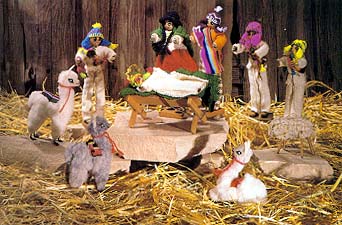“Away in a Manger,” Ensign, Dec. 1991, 39
Away in a Manger
Throughout the world, Christians celebrate the birth of the Savior Jesus Christ. The familiar events of this glorious story, found in the New Testament, center around the baby Jesus, surrounded by Joseph and Mary, several farm animals, shepherds with their lambs, and later, the wise men with their camels—all under the brilliance of a new star set in the heavens to mark Christ’s birth.
The nativity scene has been recreated thousands of times in wood, clay, and other media by artists and craftsmen from nearly every culture in the world. Its presence in homes during the holiday season serves as a reminder of His birth.
As we view such scenes, we are filled with gratitude not only for the Lord but also for his sacrifices and atonement in our behalf.
The following crèches—nativity scenes—currently on display at the Museum of Church History and Art give us a fresh perspective and an appreciation for how artists of various cultures portray the wonderful story of the Savior’s birth.

Though made from clay, this nativity scene from Guatemala takes on the sheen of porcelain as a result of white paint applied to represent the idea of divinity. (Photo by Steve Bunderson.)

Nativity figures representing the holy family, carefully crafted in Spain from terra-cotta and draped in clothing made of papier-mâché, reflect old-world elegance and reverence for Christ’s birth. (Photo by Ron Read.)

Bolivian folk artists created this nativity scene with figures and llamas built from wire wrapped with cotton stuffing and fabric. As a result, the figures are bendable and can sit, kneel, or stand in the straw. (Photo by Steve Bunderson.)

Fine-featured dolls represent Joseph, Mary, and the Christ child in the above German crèche. Clothing for these eight-inch dolls is handmade—including the knitted sweater for Joseph—and is typical of the clothing worn in Bamberg, Bavaria. (Photo by Steve Bunderson.)

Marie Percy Romero of Cochiti, New Mexico, created this painted clay nativity complete with a dog, a cow, and a donkey. The three wise men are boys with gifts of a drum, a bowl of corn, and a pair of moccasins for the Christ child. (Photo by Steve Bunderson.)

Aging improved the details of the crèche created in Hong Kong from bamboo. Mary’s arms were originally joined in the same manner as Joseph’s but when the bamboo dried, the wood split, giving her a posture of unrestrained exultation at the birth of Jesus. (Photo by Steve Bunderson.)

This African nativity scene, carved from wood, features a palm tree in addition to the holy family and several lambs. (Photo by Peggy Jellinghausen.)

Fashioned from clay by the Santa Clara Pueblo Indians of New Mexico, then specially fired to achieve a distinctive black color, the figure of Joseph (above) stands beside the Christ child while an Indian leader sits nearby, holding a feather that symbolizes the sacredness of the moment.